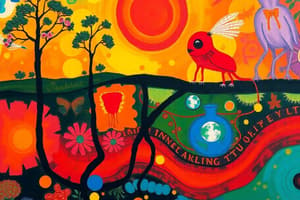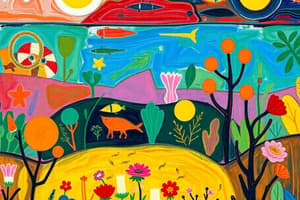Podcast
Questions and Answers
What is a key difference between an ecosystem and a community?
What is a key difference between an ecosystem and a community?
- An ecosystem consists of living organisms only.
- A community does not include abiotic factors.
- A community is a type of ecosystem.
- An ecosystem includes abiotic factors, but a community does not. (correct)
What determines the characteristics of a biome?
What determines the characteristics of a biome?
- The presence of a specific species
- Characteristic environmental conditions (correct)
- The type of ecosystem present
- The geographical area it covers
What does the term 'trophic structure' refer to?
What does the term 'trophic structure' refer to?
- The interaction between abiotic and biotic factors
- The different feeding relationships in an ecosystem (correct)
- The process of energy flow in an ecosystem
- The arrangement of organisms in a specific habitat
What is represented by a food chain or food web?
What is represented by a food chain or food web?
What is the primary difference between a community and a biome?
What is the primary difference between a community and a biome?
What determines the route of energy flow in an ecosystem?
What determines the route of energy flow in an ecosystem?
What percentage of visible light that reaches algae and leaves is converted to chemical energy via photosynthesis?
What percentage of visible light that reaches algae and leaves is converted to chemical energy via photosynthesis?
What is the term for the amount of light energy converted to chemical energy by autotrophs in an ecosystem during a given time period?
What is the term for the amount of light energy converted to chemical energy by autotrophs in an ecosystem during a given time period?
What is the difference between gross primary productivity and net primary productivity?
What is the difference between gross primary productivity and net primary productivity?
Which ecosystems have a high net primary productivity?
Which ecosystems have a high net primary productivity?
What is the approximate amount of organic matter produced per square meter per year in deserts?
What is the approximate amount of organic matter produced per square meter per year in deserts?
What is the formula for net primary productivity?
What is the formula for net primary productivity?
What is the typical pattern observed in most pyramids of biomass?
What is the typical pattern observed in most pyramids of biomass?
What is the characteristic of phytoplankton that allows them to support a large population of zooplankton despite their low biomass?
What is the characteristic of phytoplankton that allows them to support a large population of zooplankton despite their low biomass?
What is the primary reason for the inverted pyramid of biomass in some aquatic ecosystems?
What is the primary reason for the inverted pyramid of biomass in some aquatic ecosystems?
What is the main difference between the flow of energy and matter through ecosystems?
What is the main difference between the flow of energy and matter through ecosystems?
What is an example of a nutrient that is cycled between biotic and abiotic components of an ecosystem?
What is an example of a nutrient that is cycled between biotic and abiotic components of an ecosystem?
What is the primary mechanism by which energy and matter are transferred through ecosystems?
What is the primary mechanism by which energy and matter are transferred through ecosystems?
What is the primary source of nitrate for plants in the nitrogen cycle?
What is the primary source of nitrate for plants in the nitrogen cycle?
What is the role of certain bacteria in the nitrogen cycle?
What is the role of certain bacteria in the nitrogen cycle?
What is the net effect of the reciprocal processes of photosynthesis and cellular respiration on atmospheric CO2?
What is the net effect of the reciprocal processes of photosynthesis and cellular respiration on atmospheric CO2?
What happens to dissolved carbon dioxide in aquatic ecosystems?
What happens to dissolved carbon dioxide in aquatic ecosystems?
What is the main reason for the increase in atmospheric CO2?
What is the main reason for the increase in atmospheric CO2?
What is the dynamic equilibrium involved in the carbon cycle?
What is the dynamic equilibrium involved in the carbon cycle?
What happens to phosphorus that is lost from the ecosystem due to chemical precipitation?
What happens to phosphorus that is lost from the ecosystem due to chemical precipitation?
What is the primary source of phosphorus gains in terrestrial ecosystems?
What is the primary source of phosphorus gains in terrestrial ecosystems?
What is the fate of phosphorus in the soil when plants and animals decompose?
What is the fate of phosphorus in the soil when plants and animals decompose?
How can phosphorus that has accumulated in sediments become available to ecosystems again?
How can phosphorus that has accumulated in sediments become available to ecosystems again?
What is a characteristic of phosphorus in the environment?
What is a characteristic of phosphorus in the environment?
Flashcards are hidden until you start studying
Study Notes
Ecosystems and Ecology
- An ecosystem includes all living organisms (multiple communities) in a given area, as well as the abiotic factors with which they interact.
- A community consists only of living organisms in a specific area, excluding abiotic factors.
- A biome spans a large geographical area, defined by characteristic environmental conditions that determine what species can survive within it.
Trophic Structure
- Trophic structure refers to the different feeding relationships in an ecosystem that determine the route of energy flow and the pattern of chemical cycling.
- It is represented by the food chain or food web, showing the flow of material and energy among different organisms.
Energy Flows Through Ecosystems (Primary Productivity)
- Primary productivity is the amount of light energy converted to chemical energy (organic matter) by autotrophs in an ecosystem during a given time period.
- Gross primary productivity (GPP) is the total organic matter produced, including that used by autotrophs for respiration.
- Net primary productivity (NPP) is the amount of organic matter produced that is available for heterotrophs (NPP = GPP - R, where R is the energy used by autotrophs for respiration).
Productivity of Different Ecosystems
- Some ecosystems have high net primary productivity, such as swamps, marshes, and tropical rainforests (>8000 kcal/m²/year).
- Others have low net primary productivity, such as deserts (<800 kcal/m²/year) and open oceans (<1600 kcal/m²/year).
Energy Flows Through Ecosystems (Ecological Pyramids)
- Most ecosystems demonstrate a normal pyramid of biomass, with a sharp decrease in biomass at successively higher trophic levels.
- Some aquatic ecosystems demonstrate an inverted pyramid of biomass, where a small population of phytoplankton supports a large population of zooplankton.
Biogeochemical Cycles
- The movement of energy and matter through ecosystems are related, as both occur through the transfer of substances through photosynthesis, feeding relationships, and decomposition.
- Matter can be recycled within and between ecosystems, unlike energy.
The Carbon Cycle
- Photosynthesis captures carbon, while respiration returns it to the atmosphere.
- The burning of wood and fossil fuels adds CO₂ to the atmosphere.
- Dissolved CO₂ in aquatic ecosystems reacts with water to form bicarbonates.
The Nitrogen Cycle
- Plants take up nitrogen in the form of nitrate, mostly from nitrification of decomposed organic materials.
- Atmospheric nitrogen is added through nitrogen fixation, while denitrification returns nitrogen to the atmosphere.
The Phosphorus Cycle
- Phosphorus cycles within soil and water, with no atmospheric component.
- Phosphorus is lost from terrestrial ecosystems through leaching and chemical precipitation, but gained from weathering of rocks.
- Phosphorus is re-deposited in the soil when plants and animals decompose, and can become available again through geological uplifting.
Studying That Suits You
Use AI to generate personalized quizzes and flashcards to suit your learning preferences.




